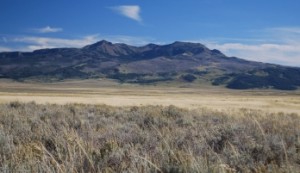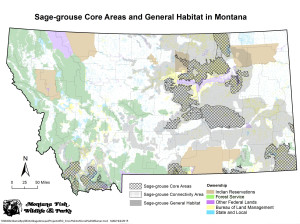Sagebrush
 For over a century, the iconic sagebrush country of the West has been degraded largely because of our cultural misunderstanding and undervaluing of it. Overgrazing, energy development, residential sprawl and invasive species are each taking their toll on this remarkably rich biome, one that blankets enormous areas of 11 western states.
For over a century, the iconic sagebrush country of the West has been degraded largely because of our cultural misunderstanding and undervaluing of it. Overgrazing, energy development, residential sprawl and invasive species are each taking their toll on this remarkably rich biome, one that blankets enormous areas of 11 western states.
The Greater Sage-Grouse has become an ambassador for this vast and rich landscape, dubbed by conservationists as the Sagebrush Sea. Sage grouse is considered an umbrella species for sagebrush communities, because conserving sage-grouse conserves numerous other plants and animals due to its need for large, healthy sagebrush ecosystems.
In recent years we’ve increased our efforts to protect sage-grouse and sagebrush habitat, collaborating with others in Montana and neighboring states on conservation planning.
In addition to the Greater Sage-Grouse, native sagebrush provides critical habitat for several bird species undergoing widespread population declines including Sharp-tailed Grouse, Ferruginous Hawk, Golden Eagle, Loggerhead Shrike, Sage Thrasher, Brewer’s Sparrow, Sage Sparrow, and more.
Sage Grouse Updates:
Winter 2017. At the 2017 Montana Legislature, we will support continued funding for Montana’s sage-grouse program through June 2019. Currently the state’s sage-grouse conservation program is funded through June 2017. In order for the program to continue, the 2017 Montana Legislature must provide funding for both the staff and a ($10 million) stewardship fund.
Fall 2016. We are working with partners to develop a state sage-grouse mitigation program and a Habitat Quantification Tool for projects that impact or restore sage-grouse habitat. The overall goal of the mitigation program is a net gain for sage-grouse (not a net loss or ‘break even’). This program will require developers to first work to avoid impacts as much as possible. If impacts cannot be avoided, then the impacts must be minimized. After avoidance and minimization are completed, the developer will need to compensate a stewardship fund for any remaining impacts. How developers reach a “net gain” for sage-grouse is yet to be determined.
September 22, 2015. Secretary of the Interior Jewell announced that the Greater Sage-Grouse is NOT WARRANTED for listing under the federal Endangered Species Act.
The US Fish and Wildlife Service reached this determination after evaluating the bird’s population status, along with the collective efforts by the Bureau of Land Management, U.S. Forest Service, state agencies, private landowners, and other partners to conserve its habitat.
- See Secretary Jewell’s announcement video.
- Read Governor-Bullock-statement-on-Sage-Grouse-Not-Warrant-9-22-2015.
- Here’s what MT Audubon’s Janet Ellis said (quote from Governor Bullock’s press release): “Today’s announcement is confirmation that Montana’s Sage grouse conservation program is on the right track. Using a science-based approach, the state will now act to conserve sage-grouse habitat in an effort to bolster this bird’s populations across Montana,” said Janet Ellis, Senior Director of Policy for Montana Audubon. “I thank Governor Bullock for stepping up to the plate to bring diverse viewpoints to the table to focus on a solution that is in the best interest of Montana and this iconic bird.”
September 8, 2015. Montana Audubon, which has worked on Greater Sage-Grouse issues for many years, supports the ‘not warranted’ decision. Governor Steve Bullock released Executive Order (EO) 12-2015, which adds additional sage-grouse conservation measures to the EO signed in September 2014 (see below). Specifically, this new EO will increase the size of the area protected by the stronger “Core Area” regulations, make it clear that commercial wind energy is prohibited in Core Areas, tighten powerline restrictions, require that Montana’s sage-grouse conservation program be running on all cylinders no later than January 1, 2016 (the first staff person started work on September 9, 2015), and more.
What is a Sage-Grouse Core Area? These areas are scientifically defensible, mapped areas of highest conservation value for sage-grouse. Core Areas were delineated by Montana Fish, Wildlife and Parks in cooperation with federal and non-governmental partners to encompass the areas with the greatest number of displaying males and associated habitat. FWP estimates the Core Areas include approximately 76% of the displaying males in Montana, as of 2013. Male counts at lek sites are assumed to represent the overall sage-grouse population. The state of Montana has designated about 9.6 million acres of Sage-Grouse Core Areas in the state (see map here); detailed maps of each Core Area, including land ownership information can be downloaded here.
 May 7, 2015. Governor Steve Bullock signed the Montana Sage Grouse Stewardship Act into law, which provides funding for 5.5 staff, as well as $10 million for sage-grouse stewardship projects. Montana Audubon played a leadership role in writing, testifying in support, and lobbying for this legislation.
May 7, 2015. Governor Steve Bullock signed the Montana Sage Grouse Stewardship Act into law, which provides funding for 5.5 staff, as well as $10 million for sage-grouse stewardship projects. Montana Audubon played a leadership role in writing, testifying in support, and lobbying for this legislation.
September 9, 2014. Montana’s Governor released his Executive Order to conserve Greater Sage-Grouse in our state (see news release). Montana Audubon’s Janet Ellis was a key member of the Advisory Council that provided a plan to Governor Bullock in January 2014, and his EO was built from that plan. Here is what Janet said when the EO was released:
“Science shows that business-as-usual will have a devastating effect on sage-grouse over the long-term. We applaud the Governor’s willingness to step up to the plate to launch this important conservation program. We all need to follow the emerging science and work closely together if our conservation efforts for this iconic species are going to succeed. And what’s good for sage-grouse and sagebrush is good for a whole host of at-risk wildlife species—making this an important conservation program for the state of Montana and our wildlife. We look forward to continuing to work with the Governor and others to make sage-grouse conservation a successful story in the state of Montana.”
Montana Audubon’s Sage-Grouse video CROSSROADS. The Greater Sage-Grouse is considered an “umbrella” species; protecting this bird across the Montana landscape will conserve many other species. Watch this five minute Montana Audubon video — Crossroads — great footage of these emblematic birds and spectacular wildlife habitat.
There are six sagebrush-dominated Important Bird Areas (IBAs) in Montana – five designated for the Greater Sage-Grouse and one nominated for its healthy populations of Brewer’s Sparrow.
Others in Montana have developed good resources and strategies for protecting sagebrush and sage-grouse:
Montana Fish Wildlife and Parks
- The state of Montana, led by FWP, has analyzed sage-grouse lek data and has developed Core Areas, General Habitat, and one Connectivity Area (see map below).
Montana NRCS has extensive resources on sage-grouse:
- Great maps with details on Core Areas
- Videos — one of the coolest sights in nature is of a sage-grouse at a lek
Birds in a Sagebrush Sea, is a great booklet describing sagebrush shrub-steppe habitat, the wildlife found using this habitat, and key measures that should be enacted for its conservation – download HERE.
